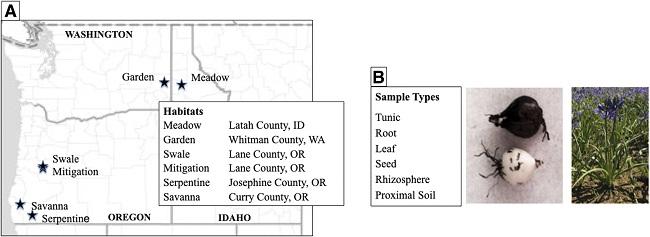
Credit: Gretchen Freed, Daniel Schlatter, Timothy Paulitz, and Frank Dugan
Camas, a seed-producing forb, grows in prairie and wetland habitats in the Pacific Northwest (PNW) and carries profound prehistoric and current significance as a food resource and article of commerce among indigenous cultures of the PNW. The forb once flourished among the region but decreased in population after the conversion to modern forms of agricultural production.
The establishment of new camas populations in prairie and wetland restoration sites in the PNW has become challenging, though. According to plant pathologist Gretchen Freed, camas populations are readily established when grown in a monoculture setting for seed increase and bulb production at the nursery.
“Camas is a keystone component of native plant restoration efforts in ephemeral wetland and prairie ecosystems in the PNW,” says Freed. “Fungal communities associated with camas seeds may provide inoculum for colonization of seedling tissues to support the establishment of camas populations in diverse plant communities. Yet little is known about the composition of the fungal communities associated with camas.”
“Seeds likely harbor communities that co-occur with camas plants and facilitate the annual growth cycle of plant tissues and the decomposition of plant debris in the soil,” says Freed. “Seed taxa may influence the local adaptation of camas seedlings to new wetland environments.”
To learn more, Freed and colleagues conducted the first comprehensive study of above- and below-ground fungal communities associated with camas using samples from wetland habitats in Oregon, Idaho, and a home garden plot in Washington. They found that the local environment of each sampled camas population had a significant impact on above-ground fungal community diversity. However, the below-ground fungal communities detected in plant tissues and closely associated soils are similar among the camas sampled in the wetland habitats.
Additionally, they found that camas plant roots may be preferentially colonized by endophytic fungi recruited from nearby soil communities suggesting that plants limit complexity of fungal communities.
The discovery of the diversity among fungal taxa present in the different types of tissues from a native plant that grows for many years is a unique opportunity to explore the endophytes that promote plant population longevity within diverse plant communities.
“What surprised us the most was the number of endophytic fungal taxa that are present among the camas seeds, roots, rhizospheres, and leaves. It is curious whether these taxa may be required for the establishment of camas populations.”
This information may help native prairie and wetland restoration scientists restore camas populations in the PNW.
###
For more information read the open access “Mycological Insights Into Wetland Fungal Communities: The Mycobiome of Camassia in the Pacific Northwest” published in the November issue of Phytobiomes Journal.
Media Contact
Ashley Bergman Carlin
[email protected]
651-994-3832
Related Journal Article
http://dx.




